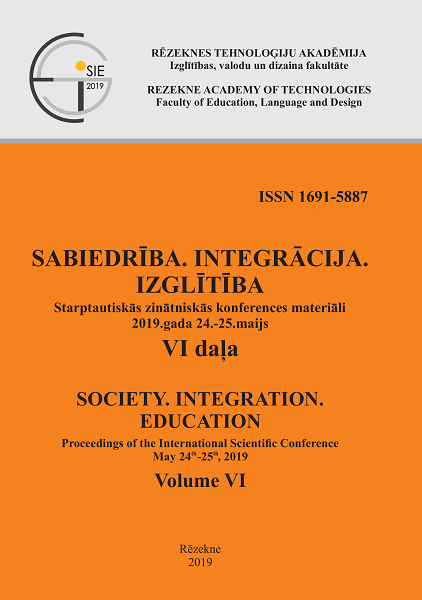EVALUATION OF THE LATVIAN STOCK MARKET AS AN INVESTMENT OBJECT
DOI:
https://doi.org/10.17770/sie2019vol6.3944Keywords:
investments, Latvia, stock, market, valuationAbstract
Development of the securities market in Latvia compared with the countries of Western Europe, Scandinavia, and North America has started much later and has been slow; therefore, the interest of individuals and companies to actively participate in the capital market can be assessed as low. The stock market that is considered as one of the types of the securities market is an unstructured environment where every investor has to decide on how to invest. The potential investor interested in stocks as an investment object can buy shares of the companies and potentially earn money despite the fact that investments in stocks are considered as a very high-risk investment. The research aim: to evaluate the Latvian stock market as one of the investment objects. The scope of the research determines the topics covered: investment opportunities in the stocks of the regulated Latvian stock exchange. The research findings point out that the performance of the Nasdaq Riga stock exchange despite its relatively small number of the issuers of shares is effective. The author concludes that use of the investment accounts is not sufficiently promoted for private individuals, consequently, the culture of savings lags behind in Latvia. In order to educate the private investors and promote decision-making on the purchase of shares, it would be advisable for the Nasdaq Riga to provide the investors with concise information on the shares of the companies and their characteristics. The quantitative and qualitative methods of economics research, including the method of comparative analysis and synthesis, as well as statistical and graphical analysis methods are used in the research.
References
Apinis, M. (2015). Biržs vilina ar peļņu. Ifinanses, aprīlis, Nr.1, 36.-39.lpp.
Capital.com (2018). Akciju indekss, Pieejams: https://capital.com/lv/akciju-indekss-definicija
Cochrane, J.H. (2011). Presidential address: discount rates. Journal of finance, 66, 1047-1108. Retrieved from: https://ej.uz/fpm9
Danns, F. (2006). Ieguldījumu akcijās vērtēšana (1.daļa). Finansists. 1 (13), 12.-13.lpp.
Finanšu instrumentu tirgus likums (2003). LR likums. Pieņemts 20.11.2003. Pieejams: https://likumi.lv/doc.php?id=81995
Grigorjeva, J. (2008). Baltijas valstu uzņēmumu finanšu rezultātu ticamības ietekmes uz akcijas ienesīgumu novērtēšana. RTU, 112 lpp.
Grišins, J. (2018). Kur zemo depozītu likmju laikā ieguldīt 1000 eiro. Dienas Bizness, 19.06.2018.
Hāka, Ž. (2017). Neizmanto visu potenciālu. Dienas Bizness, 18.12.2017.
IFinanses (2019). Nodokļu likmes. Pieejams: https://ifinanses.lv/lapas/nodoklu-likmes
InvestingAnswers (2019). Dividend yield. Retrieved from: https://ej.uz/fkaq
Islam, Md.R., Khan, T. R., Choudhury, T.T., Adnan, A.M. (2014). How Earning Per Share (EPS) Affects on Share Price and Firm Value. European Journal of Business and management, 6(17). Retrieved from: https://ej.uz/c5i7
Kaužēns, E. (2018). Kapitāla tirgus Latvijā – trešajā desmitgadē, bet joprojām vājš. Vai ir alternatīvas? Pieejams: https://ej.uz/zfkz
Ķesteris – Mālkalns, R. (2007). Lauksaimniecības uzņēmumu iespējas piesaistīt kapitālu Latvijas akciju tirgū. LLU raksti, 19(314), 37.-53.
Kumar, P. (2017). Impact of earning per share and price earnings ratio on market price of share: a study on auto sector in India. International Journal of Research. Granthaalayah, 5(2), 113-118. DOI: https://doi.org/10.5281/zenodo.345456
Latvijas balzams (2016). AS “Latvijas balzams” valdes viedoklis par izsludināto brīvprātīgo akciju atpirkumu. Pieejams: https://ej.uz/gb4m
Latvijas iedzīvotāju finanšu pratības stratēģija 2014–2020 (2014). Finanšu pratības mājas lapa. Pieejams: https://ej.uz/qnkg
Nasdaq (2019). Nasdaq Baltijas tirgus. Pieejams: https://nasdaqbaltic.com/market/?lang=lv
Par iedzīvotāju ienākuma nodokli (1993). LR likums. Pieņemts 11.05.1993.. Pieejams: https://likumi.lv/doc.php?id=56880
Pavlovs, S. (2013). Kad depozīts nesilda. IrNauda Septembris. Nr.5, 52.-54.lpp
Pavlovs, S. (2015). Liec naudai strādāt! IrNauda, 2015, jūnijs/jūlijs, Nr.19, 60.-64.lpp.
Pavlovs, S. (2018a). „Spekulanta laime” Rīgas biržā: kā nopelnīt 500% gadā. IrNauda, Jūnijs/Jūlijs, Nr.37
Pavlovs, S. (2018b). Slaveni, bet lēti. IrNauda, Aprīlis/Maijs, Nr.36
Pelane, A. (2015). Akciju tirgotāja ABC. Pieejams: https://ej.uz/dz7q
Prosad, J.M., Kapoor,S., Sengupta,J. (2015). Exploring optimism and pessimism in the Indian equity market, Review of Behavioral Finance, 7(1),60-77. https://doi.org/10.1108/RBF-07-2013-0026
Rozenfelds, J. (2018). Investēšanas kultūra Latvijā ir ļoti agrīnā stadijā. Dienas Bizness, 19.02.2018.
Sivaramakrishnan, S., Srivastava,M., Rastogi, A. (2017). Attitudinal factors, financial literacy, and stock market participation. International Journal of Bank Marketing, 35(5), 818-841, https://doi.org/10.1108/IJBM-01-2016-0012
Šķupelis, J. (2017). Baltijas akciju investori varējuši labi nopelnīt. Dienas Bizness, 22.12.2017.
Šnepste, V. (2011). Vērtspapīru tirgus Latvijā – attīstības iespējas un problēmas. Latgales Tautsaimniecības pētījumi. Sociālo zinātņu žurnāls, 1(4), 358.-372.
Spriņģis, J. (2016). Veiksmīga akcionāra portfeļa veidošana. IBizness, jūnijs, 23.-26.lpp.
Tsagkanos, A. ((2017). Stock market development and income inequality. Journal of Economic Studies, 44(1), 87-98. https://doi.org/10.1108/JES-08-2015-0155
Zaremba, A., Shemer, J. (2018). Is there momentum in factor premia? Evidence from international equity markets. Research in International Business and Finance, 46, 120–130. https://doi.org/10.1016/j.ribaf.2017.12.002
Zhang, L. (2017). Local equity market participation and stock liquidity. The Quarterly Review of Economics and Finance, 63, 101–121. http://dx.doi.org/10.1016/j.qref.2016.02.005
Zhong, A. (2018). Idiosyncratic volatility in the Australian equity market. Pacific-Basin Finance Journal, 50, 105–125. http://dx.doi.org/10.1016/j.pacfin.2017.06.010
Žuka, J. (2009). Baltijas akciju tirgus attīstības scenāriji. RTU, 93 lpp.






